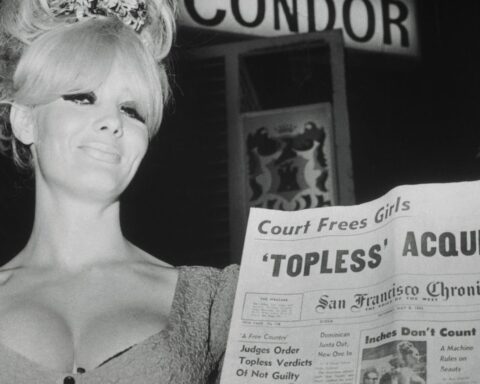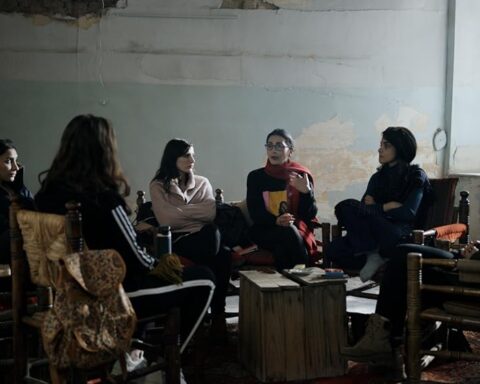The Babushkas of Chernobyl
(USA, 71 min.)
Dir. Holly Morris, Anne Bogart
The world’s most catastrophic nuclear power plant accident, the Chernobyl Disaster, occurred on April 26 1986 in Pripyat, in the former Ukrainian Republic of the USSR. Due to an emergency shutdown, nuclear reactor number 4 blew up, releasing immense amounts of radioactive waste into the atmosphere. After the disaster, the Soviet government enacted a 30 km “Exclusion Zone” around the nuclear plant, which resulted in the immediate evacuation of its residents. The zone is still largely uninhabited due to its high radiation levels.
The Babushkas of Chernobyl, directed by Holly Morris, is a feature documentary about 100 people who still live in the exclusion area. Given Chernobyl’s tragic history, one would assume the documentary to be dark and grievous in tone. But The Babushkas of Chernobyl delivers an abundance of colors, humour and vitality. And the reason for this lies in the old residents of the Chernobyl’s Exclusion Zone.
“Babushka” is a Russian word for an old woman or grandmother. Elderly women make up almost the entire population of the zone. While it is illegal to reside within a 30km radius from the Chernobyl Nuclear Power Plant, the government overlooks its residents and their lively existences. According to the authorities, the old women are more likely to die from old age rather than radiation.
The history behind the babushkas’ resettlement is stirring. After the accident, the women were evacuated to nearby cities along with everyone else from their villages. However, they couldn’t bear being away from home. The locals were stigmatizing them for bringing radiation to their towns. Rebellious and irritated, the babushkas decided to walk back to their villages. They even climbed under the barbed wire, which surrounded the zone. The babushkas have been living back home ever since.
In her documentary, Morris interviews multiple nuclear experts on the Chernobyl disaster and its repercussions. The specialists assert that anything grown or consumed inside the Exclusion Zone contains radioactive waste. But the zone’s settlers couldn’t care less about the scientific facts. Chernobyl residents drink highly polluted water and eat food from their radioactive gardens, which they proudly show to Morris. They boast about having rich harvests and are extremely fond of gardening and cooking. On special occasions, they get together and have feasts consisting of homemade Ukrainian and Russian dishes. In their 80s, the babushkas eagerly drink vodka, while some of them even brew their own moonshine.
At first, the babushkas’ carefree attitudes towards hazardous radioactive levels of the Exclusion Zone seem perplexing and absurd. As the story unfolds, however, their disdain for the authorities and health precautions becomes logical.
Most of the babushkas were born during Stalin’s purges in the 1930s. “We didn’t see anything good. We were naked and barefoot and hungry,” says Maria Shovkuta reminiscing about her youth. In order to abolish Ukrainian nationalism, Stalin infamously enforced mass starvation through all-out collectivization of the farms in Ukraine. Once known as “Europe’s bread basket” due to its agricultural production, Ukraine succumbed to famine in the ‘30s. According to some estimates, Stalin’s policy resulted in 7,000,000 deaths and is considered a genocide.
The famine was followed by World War II. According to Shovkuta, German troops were constantly passing through her village. Along with other Ukrainian teenagers, she had to dig pits and bury dead bodies of German and Soviet soldiers, who died in the fields nearby. “I wouldn’t wish it on my worst enemy. Never, ever. The things we saw,” says Shovkuta of the devastating war.
Having survived Stalin’s terror and Nazi occupation, it’s not surprising that the babushkas aren’t concerned about Chernobyl’s radiation levels. “Starvation is what scares me, not radiation,” explains Hanna Zavorotyna.
The Chernobyl women’s reluctance to leave also derives from their genuine patriotism and a cherished sense of community. The inhabitants consider Chernobyl their motherland. Besides interviewing the zone’s settlers, Morris also talks to a group of women, who didn’t return to the infamous area after the evacuation. These women have been living in the safe, nonradioactive towns and villages far away from their homes ever since the massive displacement. Despite the evident health benefits of their current surroundings, the evacuees dream about returning to Chernobyl. “Motherland is motherland,” they tell Morris, while complaining about feeling homesick and lonely.
Although residing inside the Chernobyl’s exclusion zone is undoubtedly hazardous, the babushkas assure Morris of its psychological and physical benefits. Hanna Zavorotyna, an energetic 80-year-old woman, brags about her great health and abundance of energy. Besides sustaining her garden and stocking food for the winter, she also takes care of her invalid sister. Babushka Hanna thanks God for her independence. She is confident that had she lived outside the zone she would have already died. Ironically, a recent research study has showed that the life expectancy of the exclusion zone residents is higher than of those evacuated.
While Chernobyl officially became a tourist attraction in 2011, it is simply reality for its residents. Besides the high radiation levels, Chernobyl settlers have to deal with the lack of infrastructure and state corruption. Some complain that the government fails to deliver their pensions or provide safe transportation to the community workers. Despite such difficulties, the babushkas don’t lose devotion to their land or ever regret coming back.
Babushkas of Chernobyl is incredibly moving and authentic. The documentary captures the essence of a small, estranged and exceptionally strong community. Morris delivers a curious and original spectacle by drawing a contrast between two worlds: the residents of the exclusion area and everyone else. While the rest of the world is still intimidated by the Chernobyl’s Exclusion Zone, the babushkas perceive it as their most precious gift. Enlivening the film with their genuine smiles, funny jokes and life-long friendships, the babushkas prove the importance of home and indirectly condemn the aftermath of enforced displacements.
The Babushkas of Chernobyl screens at the Female Eye Film Festival on Sunday, June 25.











